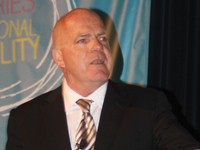Message in a song

 Fourth and last of the ULearn 12 keynote speakers was Australian Glen Capelli on the theme of Group Genius – Innovating, Educating and Collaborating.
Fourth and last of the ULearn 12 keynote speakers was Australian Glen Capelli on the theme of Group Genius – Innovating, Educating and Collaborating.
An author, songwriter, radio and television presenter and creator of the Dynamic Thinking course for Leadership, among many other accomplishments, he has delivered a message of creativity, innovation and thinking smarter to audiences around the world. His award winning television series, Born to Learn, aired weekly to 26 million households through the USA.
Capelli’s message is one of being “a learner and thinker in today’s fast paced and ever changing world through the use of creative thinking, humour, enthusiasm and attitude” and he used all of those in his address to a packed conventional hall as he had his audience totally involved and laughing frequently – usually at his unconventional use of Auslan – Australian sign language.
He began with the value of the Japanese word, kaizen, meaning a little bit of improvement every day. “It’s such an important word. When I was a kid in Kalgoorlie, if I spelled a word incorrectly, the teacher used to mark it wrong with a big, red cross. The kaizen approach is to count the letters that are correct and to tick them. If the youngster gets three letters correct out of eight, and then tomorrow they get seven letters correct out of eight, how good is that? But if you’re just marking it wrong, you’re just marking it wrong.”
Capelli used music superbly in his presentation, in one case, illustrating how the subtleties and variety in the 1969 Blood, Sweat & Tears pop song “When I Die”, written by a then 19 year old Laura Nero, was the most influential song of his life.
With the key words …”when I’m gone…there’ll be one child left to carry on,” he said “this song teaches us how to teach in today’s world.” Alluding to its changes of pace and other types of variety, he said there are “so many layers to it, so many messages within it. Sometimes you don’t need to start big – start gently. Students think they know what’s happening – then slip in some other information. Change the rhythm, weave in some layers. Add some repetition of your main message; and variety.
“Ask big questions, make big statements. Repeat your main themes over and over again.”
When the type of instrument changed, he pointed that out as an example of a teaching technique. “You don’t just teach with one instrument, you’ve got so many things in your back pack as an educator. Pull out music. Pull out a little bit of a challenge of a mathematical puzzle. Discover things and then label things. Work to variety. Shift the pace of the lesson.”
When the music slowed: “And every now and again, you pause. It’s risky but use the power of the pause to allow students to go: What have you learnt thus far? And let’s be still for five minutes and revisit. The power of the pause to go deeper.
“Different sorts of sounds, different sorts of pace. And what are the ‘yee haa moments’ the kids will remember. You keep on building, you keep on going, you keep on flowing.
“Then at the end, slow things down. “You stand still. You tell them the main message in what that lesson’s been about. What are you going to leave behind. What are they going to walk out the door, knowing. What is it that they’ll never forget because of the variety of ways you’ve been teaching them.”
Then, before closing the door on each lesson, he suggested picking up the pace again. “You want them to leave with a little bit of energy. You want them to get a little bit of tiger…you make sure you finish strong.”
Another technique was one he referred to as the three Russian brothers – Moreov, Lessov and Ridov, and their cousin, Tossin. He said it is important for teachers to know when to use ‘more of’ something, but sometimes ‘less of’ would be more advantageous and sometimes the most difficult one of all – that of getting ‘rid of’ something altogether. Occasionally the Russian cousin should be introduced and something extra ‘tossed in’ to the mix.
Capelli pointed out the need to guard against what he called the mondegreen – a word coined by journalist Sylvia Wright in 1954, where something said is misinterpreted. An example he gave was during the Queensland floods, when a farmer was widely reported as saying that 30 thousand pigs had been swept down a river. Only later did someone check and find the farmer had actually said: “…30 sows and pigs.”
A musical example Capelli gave was his own hearing impairment in the higher registers leading him to think that the words: ‘More than a woman…’ in the 1970s Bee Gees disco hit song were actually: ‘Bald headed woman…’ an interpretation which he thought actually made the song considerably more interesting. His message was to ensure that the message had always been made clearly and that everyone had understood. Repetition and variety were essential.
And on the value of co-operation: “My belief is that the community of a school gets so much richer when you work as buddies to each other, help and teamwork each other in some of the nuances of the art and the science of teaching – the beauty of being able to design crafted lessons and then to think on your feet because things can change – to call upon the repertoire that is in you back pack.”









